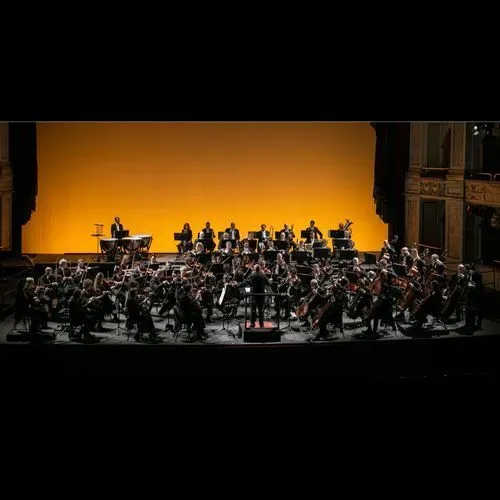



.webp)
DANIELE GATTI
A spearhead of the international music scene, one of the brightest and most appreciated conductors of his generation, Daniele Gatti leads the traditional Final Concert to Piazza Duomo . During his rich and prestigious career, he has conducted the world's leading orchestras. Today he is the Music Director of the Teatro dell'Opera in Rome and Artistic Advisor to the Mahler Chamber Orchestra.
On the program is music by Giuseppe Verdi from the French repertoire, works born out of the important artistic association the composer had with the city of Paris.
director Daniele Gatti
choirmaster Roberto Gabbiani
Orchestra and Chorus of the Teatro dell'Opera in Rome
music by Giuseppe Verdi
_Les Vepres Siciliennes _
Overture
Jerusalem
Chœur des Pèlerins: "O mon Dieu, vois notre misère."
_Macbeth _
Dances
Chœur "O Patrie! O noble terre!"
_Les Vepres Siciliennes _
Ballet des Quatre Saisons
Don Carlos
Final Act II "Autodafé"




He is Music Director of the Teatro dell´Opera in Rome and Artistic Advisor to the Mahler Chamber Orchestra. He was Principal Conductor of the Royal Concertgebouw Orchestra in Amsterdam and previously held prestigious positions withAccademia Nazionale di Santa Cecilia, the Royal Philharmonic Orchestra, the Orchestre national de France, the Royal Opera House in London, the Teatro Comunale in Bologna and the Zurich Opernhaus. New productions from he directed include Falstaff directed by Robert Carsen (London, Milan, Amsterdam),_ Parsifal_ directed by Stefan Herheim (opening Bayreuth Festival 2008), Parsifal directed by François Girard (Metropolitan Opera in New York) and _Elektra, La bohème, Die Meistersinger von Nürnberg, Il trovatore at the Salzburg Festival. He opened the seasons at La Scala with La traviata _and Don Carlo, a theater where he also conducted _Lohengrin, Lulu, Die Meistersinger von Nürnberg, Falstaff _and Wozzeck. Recent engagements include Tristan und Isolde at the Théâtre des Champs-Élysées in Paris and atOpera in Rome, _Salome _with the RCO atOpera in Amsterdam, La damnation de Faust and Rigoletto for the opening of the seasons ofOpera in Rome, concerts with the Berliner Philharmoniker, the Orchestra and Chorus of Teatro alla Scala, and the Philharmonia Orchestra of London. In 2019 he conducts the Orchestra ofAccademia Nazionale di Santa Cecilia, the La Scala Philharmonic, the Orchestra of the Maggio Musicale Fiorentino, the Staatskapelle Dresden and the Symphonieorchester des Bayerischen Rundfunks. He was awarded the "Abbiati" Prize and the honor of Chevalier de la Légion d´honneur of the French Republic.

The orchestra that inaugurated Teatro Costanzi on November 27, 1880 with Rossini's Semiramide has little to to do with the one we know today. Since 1880 various managements led the theater without succeeding to in forming a stable orchestral ensemble, due to economic problems and the irregularity of the work. A first breakthrough came in 1905 thanks to the sensitivity of Count Enrico San Martino, then an alderman: he induced the Rome City Council to establish the Municipal Orchestra composed of one hundred elements, many of them from the Municipal Band. This was in fact the Orchestra of the Teatro Costanzi until 1926. The transformation ofOpera into the Teatro Reale prompted the managers and the municipal administration to to establish a stable orchestral ensemble, albeit on a seasonal contract, so as not to have to resort to to outside professional reinforcements. Indeed, for the inauguration of the Teatro Reale on February 27, 1928 with Boito's Nerone, it was necessary to engage the Quartetto di Trieste. The final development occurred in 1935. The Municipality of Rome, through the Vice Governor Marchese Dentice di Accadia as Artistic Director, deliberated the staffing of the Teatro's workers and fixed that of the Orchestra at 143 elements including the professors of the Band, including Professor Pietro Sordi (bass tuba), Alberto's father. It was not until the 1940s that the Orchestra became a full-fledged permanent ensemble of the Theater atOpera. This enabled it to achieve international prestige collaborations with leading conductors, such as De Sabata, Gavazzeni, Karajan, Giulini, Sinopoli, Thomas Schippers, Maag, Rostropovič, Plasson, Tate, Muti and Gatti.
The Choir of theOpera of Rome has taken part in the artistic life of the Costanzi since 1935 at the behest of Tullio Serafin, Artistic Director of the then Royal Theater ofOpera. Primarily engaged in the operatic repertoire to beginning in the 18th century, the Chorus has also distinguished itself in the symphonic and sacred spheres, in concerts such as those at the Sala Nervi offered by President Giorgio Napolitano to His Holiness Benedict XVI (2011; 2012). Successful tours to Hannover for Expo 2000, to the Kremlin with Tosca (2003), to San Pietroburgo with _Nabucco _(2011), to Sydney Opera with Verdi's Requiem (2004). Fundamental to the Choir's qualitative growth are collaborations with conductors such as Serafin, De Sabata, Gavazzeni, Karajan, Böhm, Bartoletti, Giulini, Patanè, Mehta, Prêtre, Solti, Gelmetti, Muti and Gatti. Choir conductors from Italy and abroad ensured that the musical level of the Company was maintained. Among them are Maestros Conca, Lazzari, Boni, Benaglio, Parodi, Meister, Seminara and Andrea Giorgi. Directed since 2010 by Maestro Roberto Gabbiani, the Chorus has also undertaken activity in chamber music. The ensemble performed the national premiere of Rossini's Petite messe solennelle in Philip Gossett's revision. With the collaboration of the Vicariate of Rome, it has popularized the music of Mendelssohn, Schumann and Brahms in the churches of Rome. Maestro Muti conducted the Chorus in the to Palazzo Montecitorio Concert for the 150th anniversary of the Unification of Italy, at the 2013 Salzburg Festival in Nabucco and on tour to Tokyo, in the Bunka Kaikan and NHK theaters with Simon Boccanegra and Nabucco, in 2014.